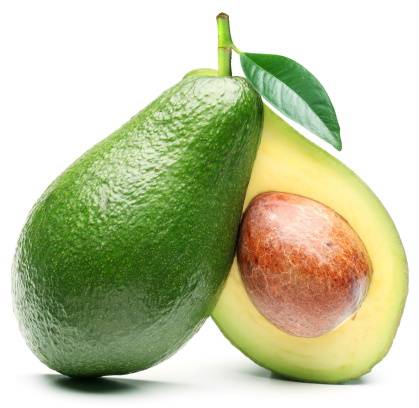To a woman, “fat” is a terrible word. Whether it’s on your body or in your food, it’s never desirable! So much conflicting information has come out about fat that you almost have to be a nutritionist in order to make the right choices at the supermarket!
Are all fats bad for you? It’s been the subject of controversy for decades – most people are still flying blind when it comes to what’s in fatty foods. It’s tough because foods can contain more than one type of fat. In general, it’s all about picking good fats to help balance the bad ones. We know that saturated and trans fats will jeopardize your health and make you gain weight. Doctors now believe that you can be much healthier (and thinner) if you consume mostly unsaturated fats: monounsaturated, polyunsaturated, and omega 3 fatty acids.
Consumed in moderation, the following types of good fats can positively affect your diet, health, and, ultimately, help you live longer and look younger.
Foods Rich in Mono and Poly Unsaturated Fats, plus Omega 3 Fatty Acids
Both fats (mono and poly) have multi benefits to your overall health: lower the risks of heart diseases, reduce bad cholesterol levels (LDL), prevent the risks of blood clots, and due to their high – diverse nutrient content, work as a vitamin absorption accelerator for the entire body.
Omega 3 fatty acids belong to the polyunsaturated fats family. They are crucial to optimal brain power – they protect you from memory loss, alleviate depression, lower blood pressure, and skin inflammation.
1. Vegetable Oils
Olive oil: this ancient – miracle food is a considerable source of monounsaturated fats, particularly oleic acid, which is essential for cardiovascular health. The ideal olive oil should be cold-pressed, extra virgin, not cooked or heated. When used for cooking, be cautious with the heating temperatures – it shouldn’t exceed more than 340 degrees in order to keep the nutritional value and to prevent oxidation, which creates trans fats!
Canola, sunflower, sesame, soybean, safflower, flaxseed, peanut, and grape seed oils: they are healthier alternatives to saturated, hydrogenated derives such as butter, margarine, lard, and tropical oils. For baking or frying, use canola oil – it doesn’t become hydrogenated at high cooking temperatures. Flax seed and sesame oils are perfect to dress salads instead of reaching for commercial fatty dressings. Exposed to light or heated, some polyunsaturated oils such as flaxseed oil turn rancid – that’s why after opening, keep them refrigerated and in an opaque bottle.
2. Filling Foods: avocado, olives, natural peanut butter, and almond/walnut butter
These are more than just simple snacks; they can be quite filling, and, when eaten in moderation, are quite healthy. Beside the beloved avocado dip, use an olive-tapenade dip or simply eat olives instead (an olive has about only 5 Cal!) When buying peanut butter, make sure that it’s natural, with no added hydrogenated oils. Almond or walnut butter is great too, and they both have lower fat content.
3. Raw Nuts: almonds, hazelnuts, cashews, pistachios, Brazil nuts, and walnuts
All of these tasty snacks play a vital role in keeping you healthy from inside out; their high mineral and vitamin content is vital towards keeping you looking great. One common one is Vitamin E, which is abundant in these nuts as wells in their derived oils. This fat soluble vitamin protects cell damage from free radicals and protects your skin from UV rays.
The best way to consume these healthy treats is raw – the honey or sugar-coated ones can double the calorie content, so stay away from candied or sugared nuts.
More stuff about nuts
– Walnuts are rich in omega 3 fatty acids, and are known for fighting skin inflammation and reducing PMS in women.
– Pistachios have the lowest calorie content among nuts: one has only 4 Cal and being in shells, the work will make you snack on less.
– Almonds are the leading source of vitamin E – 1 oz. has 35% of your daily needs.
 4. Seeds: pumpkin seeds (known as pepitas too), sesame, chia, flax, and sunflower seeds
4. Seeds: pumpkin seeds (known as pepitas too), sesame, chia, flax, and sunflower seeds
All of these should also be part of your daily diet – they are great sources of fiber, omega 3 fatty acids, vitamin E, selenium and magnesium. It’s hard to digest the idea of finding so much good stuff in these itty-bitty seeds, which are so tasty, versatile, and crunchy!
– Chia seeds are the latest fad right now since they are being studied as a potential weight loss stimulant! You can toss them into a bottle of water, mix to form a dense gel which is supposed to expand in your stomach, keeping you fuller. Amazingly, 4 Tb of chia seeds has as much calcium as 3 cups of milk!
– You can toss these seeds into everything that your palate delights: garnish soups, add a handful to your salads, sprinkle on frozen yogurt and ricotta cheese, toast them, and add them to your smoothies.
5. Cold Water Fish: salmon, anchovies, sardines, tuna albacore, trout, and mackerel
These types of fatty fish are rich in monounsaturated fats, but especially in omega 3 fatty acids. If you’re not a fish fan, you can take fish-oil supplements to absorb the healthy fats.
I still want to emphasize the fact that even those ’’ healthier’’ fats must be consumed in moderation. Be aware that all fats have 9 calories per gram, so control your portions! The American Heart Association recommends limiting even good fats to 20-35% of the calories you eat in a normal day.






















